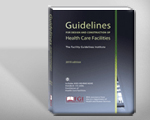The 2010 FGI Guidelines for Design and Construction of Health Care Facilities was published in January and adopted as building code by many states. How will you deal with the new noise, privacy, and acoustical requirements for healthcare facilities? Join us at SoundHealthcare 2010, a Health Care Acoustics Training Seminar (Registration is now closed), and find out what you must know about the new FGI Guidelines for HIPAA Compliance and LEED HC. The new guidelines are the culmination of over five years of collaborative work by researchers, architects, engineers, and acoustical consultants to solve the problems of speech privacy and excessive noise in hospitals. The guidelines are effective immediately for the design of all healthcare facilities.
For perspective, consider the 2006 Guidelines which mandated single patient rooms in hospitals. As a result, single patient rooms are the absolute standard in healthcare design today. This was an overnight seismic shift in policy that affected all healthcare building projects. Well, the 2010 Guidelines are no different in their sweeping reforms, addressing a whole new dimension of healthcare design, namely: acoustics, noise, and HIPAA speech privacy laws.
Controlling sound in a healthcare facility is, of course, not as easy as turning down a big knob on the wall. Sound and vibration in a healthcare setting comes from a variety of locations and is a systematic problem. According to JCAHO (Joint Commission on Accreditation of Healthcare Organizations) excessive noise raises blood pressure, extends patient stays, and can be a safety concern. Thus, for a solution to be effective, it must be holistic and comprehensive. The acoustical portion of the guideline is extensive and covers a wide range of issues including exterior noise to the community, internal noise isolation of patient rooms, speech privacy of your medical information, and vibration isolation for mechanical equipment.
The new 2010 FGI Guidelines, published in conjunction with the American Society for Healthcare Engineering (ASHE) of the American Hospital Association (AHA), is the kind of reform that is really needed to promote good healthcare today. Your conversations with your doctor about your sensitive medical condition will remain confidential. Sleeping in your hospital bed will be relaxing and comfortable – a respite from the typical noisy patient room.
At Acoustics By Design, we’ve been designing acoustical solutions for healthcare facilities for almost fifty years, and we want designers and health care planning teams to understand how the new Guidelines work in real life. Thus, we are currently collaborating with several other experts to put together a training seminar on healthcare acoustics. To learn more about our spring speaking tour highlighting the acoustical portion of the new 2010 FGI Guidelines, join us for SoundHealthcare 2010, a Health Care Acoustics Training Seminar. There is no registration fee, but you must register in advance, as space is limited.

Great article. We at Thermaflex have successfully helped support the acoustical needs in hospitals throughout the country, specifically the State of Florida AHCA by supplying our MKE product. I would be more than happy to share any information to support your efforts.
Would like more info
thanks!
Joe
Stay tuned to our website for an announcement about our upcoming spring tour highlighting the acoustical portion of the new FGI Guidelines.
Very educational – continue to spread your message. Getting excited about an update. For too long now have I had the need to begin with my own blog. Suppose if I put it off any longer I’ll never ever take action. I’ll be sure to add you to my Blogroll. Many thanks!!
Gotta love the US Congress. They’re trying to deliberately raise taxes and kill our salaries. What do you think companies are going to do when their expense per employee goes up?
Hello,this is Ila Mckinna,just discovered your web-site on google and i must say this blog is great.may I quote some of the writing found in this weblog to my local buddies?i am not sure and what you think?anyhow,Thx!
Feel free to quote or re-post our articles in context and with proper citation and links back to our original content.